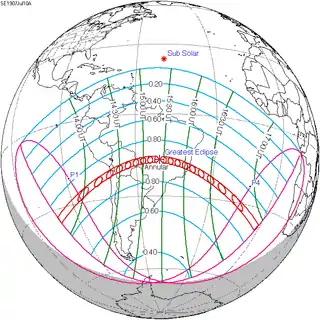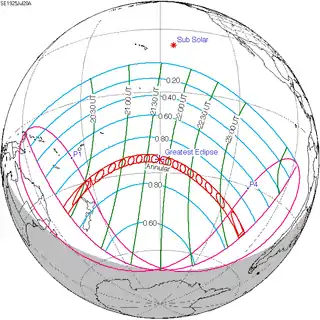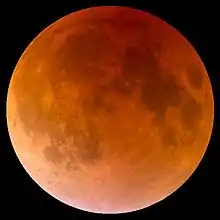July 1916 lunar eclipse
A partial lunar eclipse took place on 15 July 1916. The moon was strikingly shadowed in this deep partial eclipse which lasted 2 hours and 53 minutes, with 79% of the moon in darkness at maximum.
| Partial eclipse | |||||||||||||
| Date | 15 July 1916 | ||||||||||||
|---|---|---|---|---|---|---|---|---|---|---|---|---|---|
| Gamma | -0.59568 | ||||||||||||
| Magnitude | 0.79437 | ||||||||||||
| Saros cycle | 118 (46 of 73) | ||||||||||||
| Partiality | 172 minutes, 30 seconds | ||||||||||||
| Penumbral | 292 minutes, 24 seconds | ||||||||||||
| |||||||||||||
Observations
The Ross Sea party was a component of Sir Ernest Shackleton's Imperial Trans-Antarctic Expedition of 1914–17. Five men were stranded not far away from Cape Evans. There was sea ice between them and the relative safety of the hut on Cape Evans. On 8 May two of the men, Aeneas Mackintosh and Victor Hayward, decided to make an attempt to reach the hut. Soon after they set out, a blizzard hit. When the weather cleared up, the remaining men tried to look for them, but realized that the ice was far too thin to cross, and that their friends had been lost. Now they knew that they should wait for a thicker ice and for the full moon to attempt the crossing. Having the full moon was essential, because during polar night the moon is the only source of natural light other than the extremely dim light of the stars.
The weather did not cooperate during the full moon of June, but on 15 July, everything seemed to be just right: calm weather, thick ice, clear skies and a full moon. The men started their journey in the morning. When the moon rose, however, the men were surprised to find it was about to be eclipsed. Ernest Wild wrote later:
"I thought we were going to be left in darkness but a very little bit of the rim remained to light us..."
Although the eclipse continued for a few hours, the men were fortunate because it was only a partial eclipse. They reached Cape Evans later on the same day.[1]
Visibility


Related eclipses
Lunar eclipses of 1915-1918
| Descending node | Ascending node | |||||
|---|---|---|---|---|---|---|
| Saros | Date Viewing |
Type Chart |
Saros | Date Viewing |
Type Chart | |
| 103 | 1915 Jan 31 |
Penumbral |
108 | 1915 Jul 26 |
Penumbral | |
| 113 | 1916 Jan 20 |
Partial |
118 | 1916 Jul 15 |
Partial | |
| 123 | 1917 Jan 08 |
Total |
128 | 1917 Jul 04 |
Total | |
| 133 | 1917 Dec 28 |
Total |
138 | 1918 Jun 24 |
Partial | |
| 143 | 1918 Dec 17 |
Penumbral | ||||
Half-Saros cycle
A lunar eclipse will be preceded and followed by solar eclipses by 9 years and 5.5 days (a half saros).[2] This lunar eclipse is related to two annular solar eclipses of Solar Saros 125.
| July 10, 1907 | July 20, 1925 |
|---|---|
 |
 |
See also
- List of lunar eclipses
- List of 20th-century lunar eclipses
Notes
- Richard McElrea; David L. Harrowfield (2004). Polar castaways: the Ross Sea Party (1914–17) of Sir Ernest Shackleton. Canterbury University Press. p. 206. ISBN 978-0-7735-2825-3.
- Mathematical Astronomy Morsels, Jean Meeus, p.110, Chapter 18, The half-saros
References
- The Monthly Evening Sky Map, Volumes 9-11 Partial Lunar Eclipse of July 14–15, 1916
- Kelly Tyler-Lewis (2007). The Lost Men: The Harrowing Saga of Shackleton's Ross Sea Party. Penguin Publishing Group. p. 206. ISBN 978-1-4406-2858-0.

